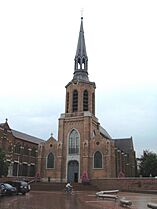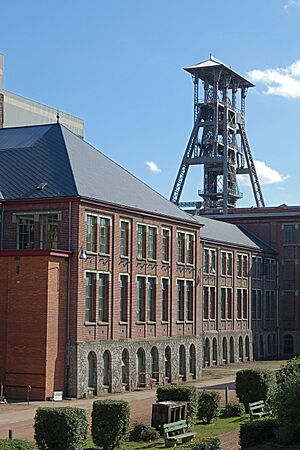Beringen, Belgium facts for kids
Quick facts for kids
Beringen
|
|||
|---|---|---|---|

St. Peter in Chains Church on Beringen Market Square
|
|||
|
|||
| Country | Belgium | ||
| Community | Flemish Community | ||
| Region | Flemish Region | ||
| Province | Limburg | ||
| Arrondissement | Hasselt | ||
| Area | |||
| • Total | 78.30 km2 (30.23 sq mi) | ||
| Population
(2018-01-01)Lua error in Module:Wd at line 1575: attempt to index field 'wikibase' (a nil value).
|
|||
| • Total | Lua error in Module:Wd at line 1,575: attempt to index field 'wikibase' (a nil value). | ||
| Postal codes |
3580, 3581, 3582, 3583
|
||
| Area codes | 011 | ||
| Website | www.beringen.be | ||
Beringen is a lively city and municipality in the Limburg province of Belgium. It's a place with a rich history and a bright future. The Beringen area includes the main town of Beringen, plus the smaller towns of Beverlo, Koersel, and Paal.
Contents
Discover Beringen's Past
Early Beginnings of Beringen
![]() County of Loon 1120–1366
County of Loon 1120–1366
![]() Prince-Bishopric of Liège 1366–1789
Prince-Bishopric of Liège 1366–1789
![]() Republic of Liège 1789–1791
Republic of Liège 1789–1791
![]() Prince-Bishopric of Liège 1791–1795
Prince-Bishopric of Liège 1791–1795
![]() French Republic 1795–1804
French Republic 1795–1804
![]() French Empire 1804–1815
French Empire 1804–1815
![]() Kingdom of the Netherlands 1815–1830
Kingdom of the Netherlands 1815–1830
![]() Kingdom of Belgium 1830–present
Kingdom of Belgium 1830–present
People have lived in Beringen since Celtic times. In 1995, archaeologists found gold coins and other old items. These items are from around 90 BC. They are the oldest gold objects from the late Iron-Age found so far north in Europe.
Other discoveries, like Roman coins, show that people settled here very early. The name 'Beringen' was first written down in 1120. It comes from a Germanic word meaning 'with the people of Bero'.
Beringen in the Middle Ages
For most of the medieval period, Beringen was part of the County of Loon. In 1239, Beringen was given its city charter. This meant it had special rights and protections. The city was protected by strong moats and walls with gates.
In 1366, the County of Loon became part of the Prince-Bishopric of Liège. Beringen became one of its 23 important cities. It stayed part of this region until 1795.
Beringen's Mining History
In 1901, André Dumont found coal in the Campine region. This led to many coal mines opening. The first coal production in Koersel started in 1919.
Coal mining was very important after World War II. It lasted until the late 1950s. After that, other energy sources became cheaper. The last coal mine in Beringen closed on October 28, 1989. You can still see the big piles of mining waste and old mining buildings around the city today.
Explore Beringen's Attractions
- The Beringen Mine Museum and its spoil tip (a hill made of mining waste) are major attractions. They show the industrial history of the area. It was once an important stop on the European Route of Industrial Heritage.
- The St. Peter in Chains Church has a beautiful spire and a rich Baroque style inside.
- Beringen is also a great place for biking. It has many good biking trails, especially in the Campine area.
Fun Events in Beringen
- Yearly Kermesses (fun fairs) happen in Beringen Paal and Koersel.
- In early August, Paal hosts a music event called "Paal op Stelten."
- The "Koersel Terrast" festival takes place in late spring. It's a two-day event with music, dance, and fireworks for everyone.
- Beringen also hosts a round of the Ethias Cross cyclocross race series. This race happens on part of the old coal mine site.
- The first round of the 2024 Exact Cross, Cyclocross Trophy was held here on October 8. Fem Van Empel won first place.
Notable People from Beringen
- Lodewijk Heyligen (1304–1361) was a Benedictine monk and music expert.
- Henricus Calenus (1583–1653) was a clergyman.
- Jo Vandeurzen (born 1958) is a politician.
- Ingrid Berghmans (born 1961) is a famous judoka (judo athlete).
- Mauro Pawlowski (born 1971) is a musician.
See also
 In Spanish: Beringen (Bélgica) para niños
In Spanish: Beringen (Bélgica) para niños





